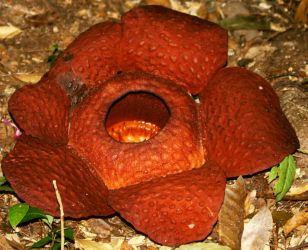
The world's largest flower is found in SE Asia
|
Flora & Fauna Areas SE Asia Flora/Fauna Related Pages Southeast Asia HomeSoutheast Asia Letters |
Southeast Asia Flora
 The world's largest flower is found in SE Asia |
This page illustrates some of the usual and unusual, but easy to find, Plant Life of Southeast Asia
Below you'll see some of the common and unusual plants of Indonesia, Malaysia and Thailand, including Kalimantan (Indonesian Borneo), the Malaysian Peninsula and Malaysian Borneo. Southeast Asia (including Indonesia) is home to thousands of species of plants, many of which are endemic (meaning they occur in one region, and no where else). This list is by no means complete - that would take several lifetimes. It simply documents those plants we deemed interesting as we traveled through the area.
|
Rainforest, mountain and river trips can be organized in Indonesia, Malaysia and Thailand. Our travels took us to Kalimantan, Indonesia, much of Malaysian Borneo (the Kinabatangan River, Mt. Kinabalu, and the forest preserves of the Crocker Range and those in Sarawak), the highlands and forests of Peninsular Malaysia (Taman Negara National Park and the Cameron highlands) and Doi Inthanon National Park in northern Thailand. An expedition into Indonesia's Tanjung Puting National Park is a great introduction to rainforest plant life and animals. To get there by boat, you sail up the Kumai River to the town of Kumai where you can hire a klotok boat to take you into the park. By air, you can fly from Jakarta (Indonesia's capital) to one of the main towns in Kalimantan such as Banjarmasin or Palangkaraya, then to Pangkalanbun, the airport nearest Kumai and the park. Guides can be arranged upon arrival or in advance. Both public and private buses depart from major cities for the Cameron Highlands and the country's largest national park, Taman Negara. There are many daily flights to Malaysian Borneo, to Kuching in the south and Kota Kinabalu in the north, from which you can arrange travel to the rivers, forests and Mt. Kinabalu. |
An interesting thing about Indonesia is that it is divided into 2 very distinct ecological regions as defined by the 19th century naturalist Alfred Wallace, whose name gave rise to the "Wallace Line". He observed that in the eastern part of Indonesia (including Papua and most of East Nusa Tenggara west through Lombok), the plants and animals more closely resemble (and are related to) those of Australia than those of Asia. To the west and north through all of Kalimantan (Indonesian Borneo), Borneo and the Malay Peninsula the plants and animals and plants are more closely related to those of Thailand and the rest of Asia.
On our travels in SE Asia we visited many eco-regions: agricultural areas where the crops of rice, coconuts, rubber, palm oil, and vegetables were grown, mangrove-lined rivers, cloud forests on Mt. Kinabalu (the highest peak in SE Asia at 13,530' or 4100m), Doi Inthanon Park in the mountainous region of northern Thailand, and some of the pristine lowland rainforests of Kalimantan, Malaysian Borneo, and Peninsular Malaysia.
There are an estimated 15,000(!!) flowering plants in Borneo, alone. Need I say, I have not undertaken to illustrate them all? (Or even a fraction of a fraction of them!) But below are some of the more common and more interesting plants we have encountered on our travels.
Two excellent field guides which we use for tropical plants are:
A Naturalist's Guide to the Tropics
by Marco Lambertini, 338 pages.
Collins Guide to Tropical Plants
by Lotschert and Beese - A Descriptive Guide to 323 Ornamental and Economic Plants.
CROPS
With millions and millions of people to feed, Southeast Asia obviously grows LOTS of food. There is absolutely no way we could present all the hundreds of edible plant species found in SE Asia, but here are a few fruits, crops and edible plants that are very common or we found particularly interesting. (Clicking on a picture brings up a larger image.)
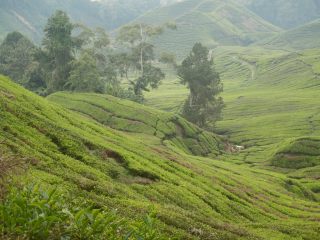 |
Another plantation crop of Southeast Asia is Tea Camellia sinensis. Grown in the highlands of Malaysia, this plant is part of the Camellia family. The top-most leaves are hand-picked and taken in bags to the tea factories. First the leaves are withered (laid out on long trays), then bruised or rolled to bring out the oils and flavor. After that they are oxidized (fermented), rolled and dried (usually in large baking ovens) then sorted to be packaged either as loose tea (with many variations) or bag tea. Black tea and green tea come from the same plant. The difference between these teas is in the processing: black tea is "fermented" (allowed to slowly dry for several days) while for green tea this step is skipped. The largest tea producer in Malaysia is Boh Tea, and you can visit their plantations and factory (and sample the wonderfully fragrant tea) at the Sungai Palas Plantation in the Cameron Highlands. |
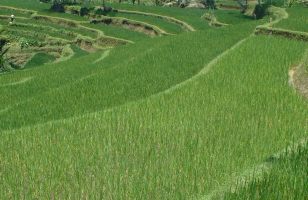 |
The #1 food crop of Southeast Asia is Rice Oryza sativa. It is a staple food for millions of people, not just in Asia but around the world. Thailand and Vietnam are two of the world's top exporters of this food crop. Rice can be grown in wet or dry fields, though the wet paddy is far more common. By growing the plants in flooded fields, many insects and other pests and undesirable plants are eliminated. Growing rice is a people-intensive operation, as the seedlings being transplanted, one by one, by hand each year. |
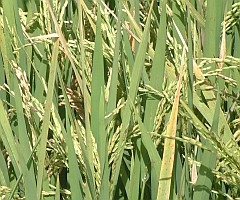 |
FLOWERING PLANTS
The world's largest flower, Rafflesia, does not grow on a bush or a tree, but emerges from a tropical forest vine called a liana. These flowers, that can measure up to 1 meter (39 inches) across, are found in parts of Indonesia, Sumatra and Malaysia. Two species are prevalent in the forests of Borneo: Rafflesia keithii (right, measuring 80 cm or 32") and Rafflesia precii (top of page). These species bloom for only 6 days, then begin to rot and within a week are nothing more than a big black pile of vegetable mush on the forest floor. New buds, which begin as dark brown spheres, grow to maturity over 9 months, and just before blooming appear as large grapefruit sized brown balls (left) on the hosting liana vine. Rafflesia are pollinated by flies, and emit a not-very-pleasant methane-like odor. |
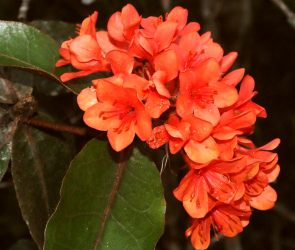 |
I first became enamored with Rhododendron while trekking in the Himalayas of
Nepal and India, and was quite pleased and surprised to learn that there are many species of
these large, showy flowers in the mountainous regions of Southeast Asia. Trekking
through tropical rainforests, with their endless hues of green, grey-green and brown, it
is wonderful to come upon the bright pink and red, or white and yellow rhododendron trees in bloom.
These two species were in bloom in October on the slopes of Mt. Kinabalu (SE Asia's tallest mountain, at over 13,000' or 4100m). We were hiking about half way up the mountain and came upon these blooming R. crassifolium (left) and R. rugosum (right). |
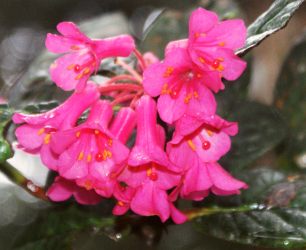 |
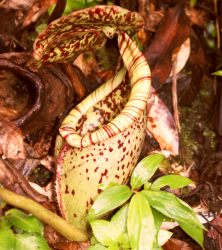 |
Pitcher plants Nepenthes spp are some of the most fascinating
members of the plant world, for they are carnivorous! Shaped like deep pitchers with
colorful lids, they attract all sorts of bugs which they digest! Many of the species
of Nepenthe are endemic to the mountains of Borneo. Some are epiphytic (living in
trees), while others climb like vines, and still others hug the ground. The "lid" on the top
is called the peristome, and can open and close to keep bugs in and to keep out rain.
Below are a few fantastic flowers we've come upon in our travels. |
 |
 Seen on Mt Brinchang at 2000m (6500') Malaysia |
 Wild ginger flower, in lowland rainforest |
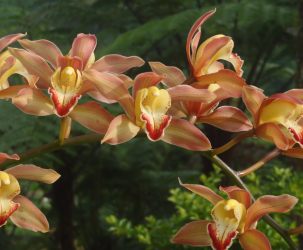 Orchids abound in Malaysia's interior |
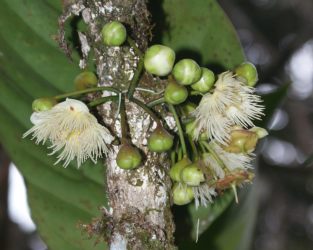 Rainforest trees may bloom on the trunk |
The rainforests of Indo Malay are home to over 10% of the world's plant species (out of approximately 250,000). More than 700 tree species have been recorded within 0.1 square kilometers in Borneo alone. So, if I don't identify these few pictures, forgive me! One characteristic of lowland rainforests is that most of the large trees have buttressed root systems like the photo to the right. Because the top soil in the rain forest is a very thin layer, these trees get the majority of their nutrients from the top few feet -- and they don't put down deep tap roots like trees in the higher latitudes do. The buttressing not only gives them support, but allows the root systems to spread out for maximum coverage of the ground to find water and nutrients. Trees in the Indo Malay forest can grow to over 50 meters (165') and some emerge above that (called "emergents") to over 70 meters (230') tall. On the left is a view up a tree in the Borneo rainforest to the canopy of leaves and branches. Because we were walking on a suspended cable walkway 40 meters (130') high when I took the picture, the canopy appears more open than it would otherwise. This area had been disturbed to build the canopy walk, so much more light penetrates the forest than normal. One aspect of the undisturbed lowland rainforest is the lack of light under the canopy, resulting in a fairly clear forest floor from which grow tree ferns, liana vines (think of Tarzan!) and young trees reaching for the light. Most plants on the forest floor have large leaves to collect as much light as possible. All photos on this website are copyrighted material. |
Top Level: Home | Destinations | Cruising Info | Underwater | Boat Guests | Ocelot | Sue | Jon | Amanda | Chris | Site Map | Make a Comment
|
If our information is useful, you can help by making a donation |
Copyright © 2000‑ Contact: Jon and Sue Hacking -- HackingFamily.com, svOcelot.com. All rights reserved.